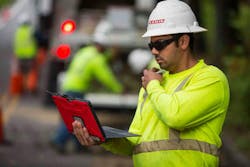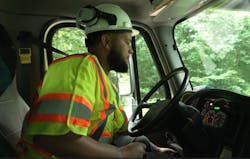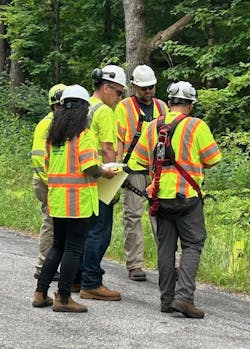The utility vegetation management (UVM) industry is steadily embracing significant changes. For many years, UVM crews were tasked with the considerable responsibility of keeping the power on while using very basic equipment and limited resources. Practices were often handed down by word-of-mouth from crew leaders to craftworkers, and decisions were frequently made using old data sets.
Fortunately, important changes are well underway, and technology is helping to lead the charge. These changes—fueled by groundbreaking innovations—are resulting in greater efficiencies, increased safety and enhanced productivity in the UVM sector at a time when the demand for reliable power is at an all-time high and ever-increasing peak.
Paving the Way for Transformative Change
At Lewis Services, digital transformations are taking place across the company using a comprehensive strategy that encompasses people, processes, and technology. From department to department, nearly all Lewis initiatives incorporate some level of technology, whether it’s fleet modernization projects, advancements in communication, safety improvements in the field, financial analysis, risk assessment and mitigation or business development—all focused on delivering first-rate service to customers and fulfilling Lewis’ mission.
It’s safe to assume that most businesses are continuously ramping up their usage of technology as well. For many, the challenge isn’t a shortage of digital options—it’s more likely an abundance of choices. Digital improvements can run the spectrum from buying new cell phones to implementing corporate-wide artificial intelligence systems. Investments of this magnitude require more than a healthy budget—they require change leadership and strategic planning.
Superior systems alone do not guarantee transformative success. The most promising initiatives will crash and burn without a clear process that leads staff through the common stages of denial (I don’t need this), resistance (I don’t want this), exploration (I might use this) and acceptance (I’m going to implement this). Digital transformation requires a cultural shift that embraces innovation, experimentation, training and continuous learning. To foster this culture of change acceptance, companies need to encourage creativity, empower employees to take risks and actively promote adaptability and agility.
Change itself can be the hardest obstacle to overcome in any aspect of new technology, applications or even process changes within an organization. Often overlooked, training becomes a critical harbinger foreshadowing the success (or failure) of change. Said differently and possibly more bluntly, success hinges on not only the content that is being delivered—but the way it’s being delivered.
Tackling the Digital Divide
For example, Lewis is continuously investing in systems that improve safety, service, compliance and operational efficiency. These systems often require some form of training for many, if not all, Lewis employees. In an office setting where everyone has laptops, cell phones, uninterrupted access to the internet and collaborative workspaces like Microsoft Teams—training can be coordinated fairly easily. However, with a distributed workforce of 4000+ working in the field, across 27 states, with inconsistent cell service and varying levels of access to technology—training is no longer so simple.
To tackle this digital divide, Lewis’ Information Technology (IT) department recently embarked on a technology expansion program that was rolled out across all divisions in the company. The program’s objectives were two-fold: 1) continue to build a technology foundation that supports digital transformation and operational modernization, and 2) make technology improvements readily accessible to every person in the company.
The initiative included deployment of multi-use tablets to every field crew for training, inspections, reports, communications, GPS navigation and more. Understanding that adoption of new technology takes time, the IT team worked diligently to ensure that each step of the process—from deployment to usage—was well-researched and took into consideration equity-based variables such as language, location, role and digital experience.
Initial responses to this program have been overwhelmingly positive and encouraging. As tablet usage continues and new apps are added to the devices, Lewis is on a path toward global adoption of the technology, enhanced communication across the company and generation of new data that will fuel future progress.
Driven by Data
One of the most profound advancements in UVM in the recent past has been the evolution of data production, analysis, storage and security. The ability to generate, store and quickly access critical data using technology has been a game changer for Lewis and industry colleagues—especially when it comes to project planning and execution.
In their article “The Evolution of Vegetation Management Technologies,” John Brickley and Brandon Browning suggest, “From production forecasting to process and system modeling and optimization, identifying and implementing appropriate vegetation management (VM) technology is now crucial to ensuring the successful outcome of VM projects. VM technology has gone through a series of transformations in the recent past, allowing utilities and contractors to utilize large data sets to better understand and evaluate risk factors in their VM programs.”
To manage this immense data, Lewis has instituted cloud computing and migrated operations and data storage to cloud platforms for improved scalability, accessibility and cost-efficiencies. This move has provided virtually limitless storage of important data that is readily accessible for analysis, reference and usage. Instant retrieval of data and analytics allows extraction of insights from large volumes of data, enabling data-driven decisions and optimal processes. Lewis teams are able to access data from any location, enabling ongoing collaboration and business continuity.
Another benefit of cloud computing has been the ability to increase and enhance customer interactions. By leveraging digital technologies, Lewis can provide seamless and personalized customer engagement across multiple channels, including websites, mobile apps, social media and email. These customized experiences help to build partnerships, celebrate successes and curate content that adds value to customers’ needs.
Cybersecurity Strategies
With this epic change in data usage is the equally epic responsibility to protect that data. Threats to cybersecurity at home and abroad have prompted companies to invest in security programs and protocols to thwart cyber malfeasance. Lewis has implemented company-wide measures such as encryption, multi-factor authentication and threat detection systems to protect data and systems from breaches. Constant vigilance, program maturation and ongoing training have been critical for maintaining optimal security, mitigating risk and reducing possible exposure.
Cybersecurity requires company-wide commitment and starts with a strong data governance program that includes clear classifications (e.g. public, internal, confidential and restricted) and secure access rights. Also critical are well-established processes and procedures in the event of ransomware incidents, personnel changes and external failures. Being proactive and instituting network defense initiatives puts organizations in a more secure position and provides end point protection.
Even with extensive scenario planning and revolutionary protections, it is imperative for companies to arm their most valuable resource—their staff—with cybersecurity education. At Lewis, a 100% employee-owned company, the “human firewall” is formidable. Thanks to an expansion of the company’s annual Cybersecurity Education and Training Program, staff members understand their role as cybersecurity associates and have been empowered to raise the red flag when they sense situations that could jeopardize the company and its customers.
End User Benefits
New York City may be “the city that never sleeps” but UVM has the technology that never sleeps—and for good reason. As the guardian of data that helps to keep the power on and the country running, technology is serious business in the UVM sector. At Lewis, technological advancements in the corporate office—such as cybersecurity programs—protect customer, company and employee data. In the field, safety programs—prioritizing job-site safety, driver performance and vehicle compliance—protect workers, customers and the community.
Technology touches every part of industry operations. As part of his series, “Building a Tech-Savvy Workforce: The Importance of Employee Training in Technology Adoption,” Daniel Bron suggests, “Digital transformation is not merely about replacing analog processes with digital ones or adopting the latest tech gadgets. It's about leveraging technology to reimagine and reinvent the way we work, the way we think and the way we create value. It's a holistic metamorphosis permeating every facet of an organization, from its operational processes to its business strategies, customer interactions and organizational culture.”
The digital frontier is expansive, exciting and full of promise—but change can be intimidating and requires hard work. So how do we move forward without leaving others behind? We employ change leadership to set the course. We embrace accountability and innovation to stay the course. And we use the power of technology to conquer the course.
E. Huntley Hedrick ([email protected]) has served as vice president of technology at Lewis since 2020. He is responsible for implementing and maintaining the organization’s current technology systems and planning the adoption of future technologies. He also leads the cybersecurity and data protection programs. Throughout his career, Hedrick has worked for large corporations building advanced IT processes and tools including Bausch + Lomb, EDS and Ultralife Corporation.
About the Author
E. Huntley Hedrick
E. Huntley Hedrick ([email protected]) has served as vice president of technology at Lewis since 2020. He is responsible for implementing and maintaining the organization’s current technology systems and planning the adoption of future technologies. He also leads the cybersecurity and data protection programs. Throughout his career, Hedrick has worked for large corporations building advanced IT processes and tools including Bausch + Lomb, EDS and Ultralife Corporation.



